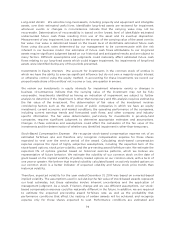Yahoo 2014 Annual Report Download - page 82
Download and view the complete annual report
Please find page 82 of the 2014 Yahoo annual report below. You can navigate through the pages in the report by either clicking on the pages listed below, or by using the keyword search tool below to find specific information within the annual report.determine fair value based on estimated future cash flows of each reporting unit discounted by an
estimated weighted-average cost of capital, reflecting the overall level of inherent risk of a reporting
unit and the rate of return an outside investor would expect to earn. Determining the estimated fair
value of a reporting unit is judgmental in nature and requires the use of significant estimates and
assumptions, including selection of market comparables, estimated future cash flows, and discount
rates.
These components are discussed below:
•Market comparables. We select comparable companies in the specific regions in which these
reporting units operate based on similarity of type of business, primarily those involved in online
advertising, relative size, financial profile, and other characteristics of those companies compared
to these reporting units. Trailing and forward revenue and earnings multiples derived from these
comparable companies are applied to financial metrics of these reporting units to determine their
estimated fair values, adjusted for an estimated control premium.
•Estimated future cash flows. We base cash flow projections for each reporting unit using a
forecast of cash flows and a terminal value based on the Perpetuity Growth Model. The forecast
and related assumptions were derived from the most recent annual financial forecast for which
the planning process commenced in our fourth quarter. Key assumptions in estimating future
cash flows include, among other items, revenue and operating expense growth rates, terminal
value growth rate, and capital expenditure and working capital levels.
•Discount rates. We employ a Weighted Average Cost of Capital approach to determine the
discount rates used in our cash flow projections. The determination of the discount rates for each
reporting unit includes factors such as the risk-free rate of return and the return an outside
investor would expect to earn based on the overall level of inherent risk. The determination of
expected returns includes consideration of the beta (a measure of volatility) of traded securities
of comparable companies and risk premiums of reporting units based on international cost of
capital methods.
The components above require us to make assumptions about the timing and amount of future cash
flows, growth rates and discount rates. Significant management judgment is involved in determining
these estimates and assumptions, and actual results may differ from those used in valuations.
Changes in these estimates and assumptions could materially affect the determination of fair value
for each reporting unit which could trigger future impairment. To facilitate a better understanding of
how these valuations are determined, a discussion of our significant assumptions is provided below.
Discount rate assumptions for these reporting units take into account our assessment of the risks
inherent in the future cash flows of the respective reporting unit and our weighted-average cost of
capital. We also review marketplace data to assess the reasonableness of our computation of our
overall weighted average cost of capital and, when available, the discount rates utilized for each of
these reporting units.
In determining the fair value of all of the reporting units, we used the following assumptions:
• Expected cash flows underlying our business plans for the periods 2015 through 2025.
• Cash flows beyond 2025 are projected to grow at a perpetual growth rate.
• In order to risk adjust the cash flow projections in determining fair value, we utilized discount
rates of approximately 11 percent to 19 percent for each of these reporting units.
See “Operating Costs and Expenses — Goodwill Impairment Charge” for additional goodwill
impairment information for the years ended December 31, 2013 and 2014 and also Note 5—“Goodwill”
in the Notes to our consolidated financial statements.
78
























